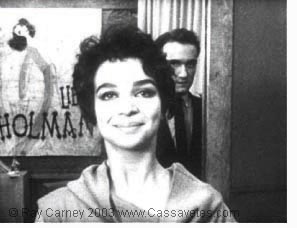|
 One
of the hallmarks of Cassavetes' work is the multiple-stranded
narrative.
While Hollywood is premised on an identification strategy in which
the viewer processes information in terms of a single, dominant
understanding of what things mean (generally figured by the star's
viewpoint, though the understanding may be shared with or parceled
out among several main characters), none of Cassavetes' films is
organised in this way. Life contains many different stories
and
alternative points of view. The narrative circulates the viewer
through alternative perspectives and relations to experience – no
one of which is necessarily more important, virtuous or correct
than any other. One
of the hallmarks of Cassavetes' work is the multiple-stranded
narrative.
While Hollywood is premised on an identification strategy in which
the viewer processes information in terms of a single, dominant
understanding of what things mean (generally figured by the star's
viewpoint, though the understanding may be shared with or parceled
out among several main characters), none of Cassavetes' films is
organised in this way. Life contains many different stories
and
alternative points of view. The narrative circulates the viewer
through alternative perspectives and relations to experience – no
one of which is necessarily more important, virtuous or correct
than any other.
It is crucial to the
effect of the film that Shadows tells three stories at
once, and grants Hugh, Lelia and Ben independent identities,
sets of friends,
and problems to deal with. In a narrative paradigm that will be
repeated in all of Cassavetes' subsequent films, the initial
scenes
present the characters separately so that the viewer can get to
know and care about each as an individual; the middle section
brings
the figures together in extended interactions with each other so
that differences in temperament and behaviour can be registered,
and the closing scenes separate the characters one final time and
provide separate conclusions to their individual stories. The
narrative
even-handedness prevents any one figure from "starring" or relegating
the others to merely "supporting" status. Though Lelia has
more
on-screen time than either of her brothers, in no sense can Hugh
or Ben be said to be merely supporting figures in "her" movie.
No
matter how gripping or painful her personal drama is, she is not
allowed to take over the film and make it hers. The effect
is simultaneously
invigorating and chastening. The switches from one figure's story
to another's keep each "in his place." Even as one character
demands
our attention and sympathy, the others make equally important and
conflicting claims on our feelings.
Shadows, Published
by the British Film Institute (London, England)
Distributed in America by
the University
of California Press at Berkeley
ISBN: 0-85170-835-8
88 pages; thirty illustrations
This
page only contains excerpts and selected passages from Ray Carney's
writing about Shadows. To obtain the complete text as well
as the complete texts of many pieces about Cassavetes that are not
included on the web site, click
here.
|









